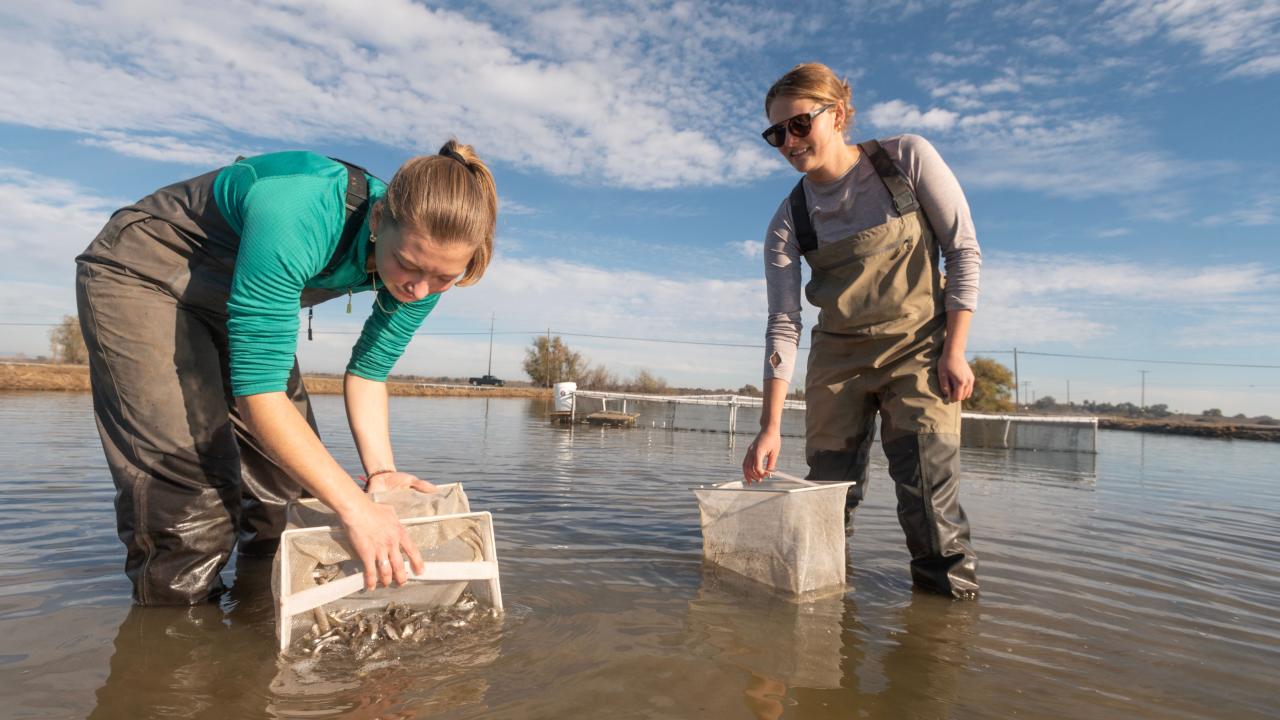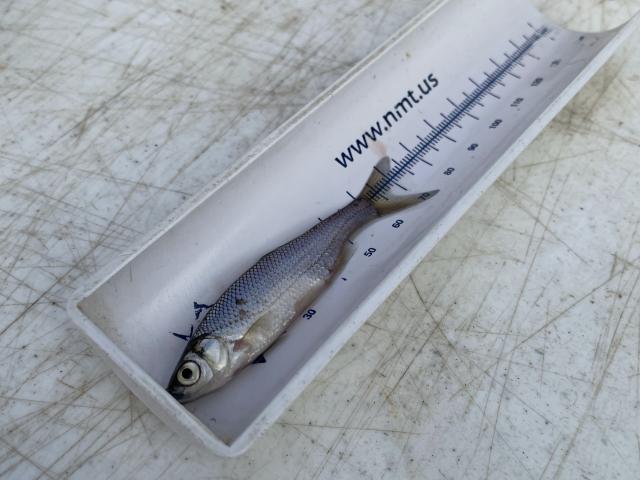
Birds and Fish in Flooded Rice Fields: Promoting Biodiversity and Climate Protection
Study on How Birds and Fish Influence Rice Production and Reduce Methane Emissions
Wading through flooded rice fields, a team of UC Davis students and researchers release thousands of shimmering fish into the water. These small golden shiners hold the promise of significant contributions to the dual challenges of climate change mitigation and sustainable food production.
Flooding rice fields in the winter plays a crucial role in both agricultural productivity and wildlife habitat conservation. This practice breaks down rice straw left after harvest, and it enriches the soil for the next crop cycle. It also creates shallow wetland habitats that attract and support millions of migrating waterfowl and other animals.
“Rice is one of the few examples in the world of industrial, large-scale agriculture that can also conserve wildlife at the same time,” said Daniel Karp, associate professor with the Department of Wildlife, Fish and Conservation Biology and principal investigator of the project.
The experiment is taking place at Montna Farms, a family owned and operated business recognized as one of the leading rice producers in the Sacramento Valley, a growing region known for producing nearly all of America’s sushi rice. Jon Munger, vice president of operations, said they have the huge task of getting rid of about 3-to-4 tons of rice straw per acre, the byproduct of a rice crop. The burning of rice straw after harvest was a common practice historically, but raised environmental concerns due to poor air quality, greenhouse gas emissions and health impacts. Munger said Montna Farms and other rice growers turned to flooding the fields instead, which helps rice straw decompose while also providing habitat for migrating birds.
“California has lost 95% of its wetlands in the Central Valley, so when the rice straw started getting flooded in the winter to break down the straw, it became surrogate wetland,” Karp explained. “Whereas most North American birds are in decline, waterfowl aren’t, and I think a big reason for that is because of practices like this. We have this surrogate wetland now that supports millions of migratory birds coming down to visit rice fields during the winter. It also supports other important creatures, from giant garter snakes to sandpipers and other shorebirds.”
Balancing act
Like all plants, rice needs water to grow. Drought conditions pose significant challenges for rice farmers, impacting both crop yields and economic viability. Approximately 500,000 acres of rice is grown each year in California and dealing with dry conditions is something farmers at Montna Farms and across the state know all too well.
“In 2022, we were half of those acres due to the extreme drought we had; it was very challenging,” Munger said.
With escalating water costs, the future of winter flooded rice fields in California may be in jeopardy. “The question is how do we keep getting rice fields flooded into the future to support California’s wildlife and share this landscape? Maybe we can identify benefits that wildlife could provide to farmers and offset some of the water costs,” said Karp.


Fish and birds to the rescue
Karp and his team are assessing how visiting waterbirds and the introduced golden shiner influence rice production and if they offer farmers a viable strategy for encouraging winter field flooding. The team is conducting controlled experiments in eight, quarter-acre plots, each piped with its own water source. In the fall, they released 10,000 fish to half of the plots, or approximately 5,000 fish per acre. They also built large cages to prevent waterbirds from entering some areas so they can compare what happens in the plots that have both fish and birds, as well as plots that have just fish or just birds, or neither birds or fish. By setting up the different scenarios, researchers can see how fish and birds are interacting and whether they can live harmoniously in the rice fields.
“We’ll look at bird visitation, quantify their behaviors, figure out how many fish they are eating, and ultimately assess how birds and fish affect rice production,” Karp said.
In addition to taking measurements of the fish and conducting bird surveys, the research team regularly obtains air, water and soil samples. They will also harvest the rice grown in the experimental plots.
The team is trying to determine if fish and birds can help control weed seeds in rice fields, reducing the need for chemical herbicides. Fish and bird feces could also serve as organic fertilizers. The researchers are measuring the nutrient content of the water, soil and rice crops to see if fish and birds promote rice growth.
“One of the reasons why this project is so interesting is because we’re trying to benefit wildlife and people,” said Emily Mensch, project coordinator and ecology Ph.D. student who focuses on fish conservation and bridging human landscapes and wildlife habitats.

Climate’s double-edged sword
For many years, the rice industry has been actively involved in conservation efforts, particularly related to water management and wildlife habitat preservation. Like most food production, rice also confronts a climate dilemma: it bears the brunt of extreme weather patterns like droughts and floods, yet its cultivation emits greenhouse gases. The Intergovernmental Panel on Climate Change, established by the United Nations, estimates global rice cultivation contributes around 10-15% of methane emissions.
Munger hopes participating in this research will help bolster resilience and sustainability for growers.
“We have to, as an industry, look at things like this to be able to survive and adapt,” Munger said.
This is where the fish could help. The golden shiner is a minnow species often used as bait fish in recreational fishing. The small freshwater fish have a knack for making themselves at home wherever they go, which is why Mensch says they can thrive in flooded rice fields.
These fish also have an appetite for algae, insect larvae and plankton, which can be of utmost importance.
“These fish go in the rice fields, and they graze on zooplankton, which eat these bacteria that then eat methane, so reducing the zooplankton might actually increase the bacteria and decrease methane,” Mensch said.
William Horwath, a distinguished professor of soil biogeochemistry and chair of the Department of Land, Air and Water Resources, said using the latest instrumentation, methane emissions are being recorded in real-time.
“We have some preliminary findings that these fish are reducing methane emissions, which would then make the global warming footprint of growing rice in California much more of a positive outcome,” said Horwath, the J. G. Boswell endowed chair in soil science.

More benefits from farmland fish
Fish are increasingly being studied in winter-flooded rice fields. According to Andrew Rypel, professor with the Department of Wildlife, Fish and Conservation Biology and an investigator of the project, the physical and chemical conditions appear to largely mimic those seen in California’s natural wetlands.
“Some work in our group, and that of others, has shown that winter-flooded rice can make for outstanding habitat for juvenile Chinook salmon migrating to the ocean,” Rypel said. “Adding a winter practice focused on fish production would greatly expand the footprint of rice farms that could participate in this kind of work.”
Just like with waterbirds and rice, UC Davis researchers are beginning to understand the potential for these habitats to help grow fishes. If the shiners grow well in rice fields, then fish like these shiners could also become a secondary crop for farmers. At the end of the winter, farmers could sell the fish as bait or as a carbon-negative protein source.

Fieldwork findings
The research team implanted about one third of the fish with Passive Integrated Transponder (PIT) tags or small, pill-shaped radio transponders that uniquely identifies each fish. Using the facilities at the UC Davis Center for Aquatic Biology and Aquaculture, undergraduate and graduate students got hands-on experience delicately implanting the tags in the fish before they were transported from campus to Montna Farms.
“We’re tracking growth and mortality over time, partially to understand biological interactions with the birds, but also to see if they grow really well in these conditions,” Mensch said.
Preliminary data, according to Mensch, shows substantial growth among the fish, including a 52% increase in weight from introduction to recapture.
This summer will conclude one year of fieldwork to be repeated starting this fall.
Looking ahead, Karp and Rypel hope findings from this study may provide a path forward for sharing farming landscapes with California’s native fish, many of which are facing devastating population declines.
“Maybe we can think beyond shiners and help recover some of the declining fish populations in California with rice as well,” Karp said. “83% of California’s fish are either extinct, in danger of becoming extinct or highly threatened. This is a great opportunity.”
This project is being funded by a grant from the U.S. Department of Agriculture.
Media Resources
- Daniel Karp, Department of Wildlife, Fish and Conservation Biology, dkarp@ucdavis.edu
- Emily Mensch, Department of Wildlife, Fish and Conservation Biology, emensch@ucdavis.edu
- Andrew Rypel, Department of Wildlife, Fish and Conservation Biology, rypel@ucdavis.edu
- William Horwath, Department of Land, Air and Water Resources, wrhorwath@ucdavis.edu
- Tiffany Dobbyn, College of Agricultural and Environmental Sciences, tadobbyn@ucdavis.edu